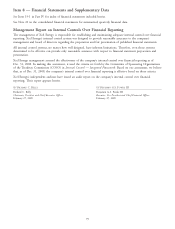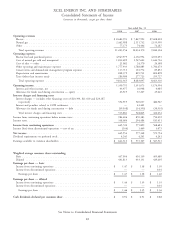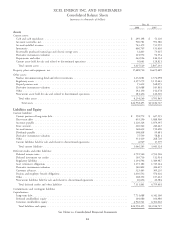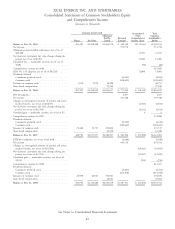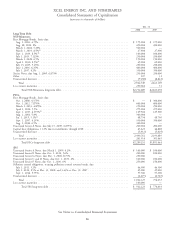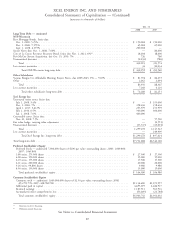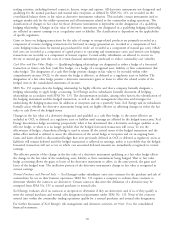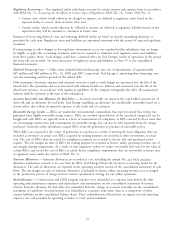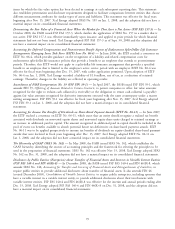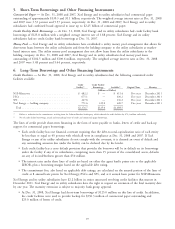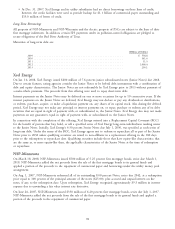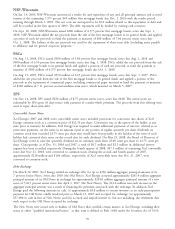Xcel Energy 2008 Annual Report Download - page 99
Download and view the complete annual report
Please find page 99 of the 2008 Xcel Energy annual report below. You can navigate through the pages in the report by either clicking on the pages listed below, or by using the keyword search tool below to find specific information within the annual report.• NSP-Wisconsin’s rates in Wisconsin include a cost-of-gas adjustment clause for purchased natural gas, but not
for purchased electric energy or electric fuel. In Wisconsin, requests can be made for recovery of those electric
costs prospectively through the rate review process, which normally occurs every two years, or an interim
fuel-cost hearing process.
• PSCo generally recovers all prudently incurred electric fuel and purchased energy costs through the ECA for the
company’s retail jurisdiction. The ECA is an incentive adjustment mechanism that compares actual fuel and
purchased energy expense in a calendar year to a benchmark formula. The ECA includes an incentive adjustment
to encourage efficient operation of base load coal plants and encourage cost reductions through purchases of
economical short-term energy. The total incentive payment to PSCo in any calendar year will not exceed
$11.25 million. The ECA mechanism is revised quarterly and interest accrues monthly on the average deferred
balance. The ECA will expire at the earlier of rates taking effect after Comanche 3 is placed in service or
Dec. 31, 2010.
• PSCo generally recovers all purchased capacity costs through the PCCA for the company’s retail jurisdiction. The
PCCA mechanism is revised annually.
• In Texas, SPS recovers fuel and purchased energy costs through a fixed fuel and purchased energy recovery factor,
which is part of SPS’ retail electric rates. The Texas retail fuel factors change each November and May based on
the projected costs of natural gas. In New Mexico, SPS has a monthly fuel and purchased power cost-recovery
factor.
• NSP-Minnesota operates under various service quality standards, which could require customer refunds if certain
criteria are not met. NSP-Minnesota rates in Minnesota include monthly adjustments for recovery of
conservation and energy-management program costs, which are reviewed annually. NSP-Minnesota is allowed to
recover certain costs associated with new transmission facilities to deliver renewable energy resources and certain
costs associated with production facilities through rate riders.
• PSCo’s rates include annual adjustments for the recovery of conservation and energy-management program costs,
which are reviewed annually. PSCo is allowed to recover certain costs associated with renewable energy resources
through a specific retail rate rider. In January 2008, a new recovery mechanism for transmission commenced.
The TCA permits PSCo to recover costs associated with investment in transmission facilities made after March
2007 through a rate rider.
• NSP-Minnesota, NSP-Wisconsin, PSCo and SPS sell firm power and energy in wholesale markets, which are
regulated by the FERC. Certain of these rates include monthly wholesale fuel cost-recovery mechanisms.
Commodity Trading Operations — All applicable gains and losses related to commodity trading activities, whether or
not settled physically, are shown on a net basis in the consolidated statements of income.
Xcel Energy’s commodity trading operations are conducted by NSP-Minnesota, PSCo and SPS. Commodity trading
activities are not associated with energy produced from Xcel Energy’s generation assets or energy and capacity purchased
to serve native load. Commodity trading contracts are recorded at fair market value in accordance with SFAS No. 133,
Accounting for Derivative Instruments and Hedging Activities (SFAS No. 133). In addition, commodity trading results
include the impact of all margin-sharing mechanisms. For more information, see Note 13 to the consolidated financial
statements.
Fair Value Measurements — Xcel Energy presents cash equivalents, interest rate derivatives, commodity derivatives, and
nuclear decommissioning fund assets at estimated fair values in its consolidated financial statements. Cash equivalents
are recorded at cost plus accrued interest to approximate fair value. Changes in the observed trading prices and liquidity
of cash equivalents, including commercial paper and money market funds, are also monitored as additional support for
determining fair value, and losses are recorded in earnings if fair value falls below recorded cost. For interest rate
derivatives, quoted prices based primarily on observable market price curves are used as a primary input to establish fair
value. For commodity derivatives, the most observable inputs available are generally used to determine the fair value of
each contract. In the absence of a quoted price for an identical contract in an active market, Xcel Energy may use
quoted prices for similar contracts, or internally prepared valuation models as primary inputs to determine fair value.
For the nuclear decommissioning fund, published trading data and pricing models, generally using the most observable
inputs available, are utilized to estimate fair value for each class of security.
Types of and Accounting for Derivative Instruments — Xcel Energy and its subsidiaries use derivative instruments in
connection with its interest rate, utility commodity price, vehicle fuel price, short-term wholesale and commodity
89


